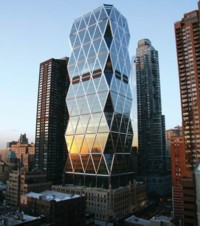LEED 2009: Ironing out the wrinkles
 The U.S. Green Building Council (USGBC) has released the newest version of LEED (v3.0) in an attempt to address longstanding concerns over technical details and the arduous review and certification process.
The U.S. Green Building Council (USGBC) has released the newest version of LEED (v3.0) in an attempt to address longstanding concerns over technical details and the arduous review and certification process. LEED certification has often been criticized for its confusing documentation requirements and lengthy project reviews. Some critics have suggested the consensus process used to develop the system is not backed by hard science.
Nonetheless, in the last 11 years LEED certification has been widely accepted as a standard measure for sustainable buildings. The USGBC has approved a total 21,000 projects, representing over 5 billion sq feet of construction, and LEED certification requirements have found their way into municipal building codes and government regulations.
LEED 2009 has made several adjustments to multiple areas of concern that should serve to improve the building rating system, the online monitoring an updating tool, as well as the certification and administration process.
LEED Rating Systems
Previously, individual rating systems each had their own point totals. For example LEED for Commercial Interiors could earn 57 points in total while LEED for New Schools could earn a maximum of 79 points.
In the new system, uniform certification sets a threshold across all the rating systems and introduces new standards based on a 100-point scale. Forty points is the lowest level for certification, while 80 points, or platinum certification, is the highest level an individual building project can achieve.
To achieve 100 points, or more, projects must focus on regional development and other innovations that extend beyond one particular building. For example, a project in New York State could earn extra points for preserving agricultural land, reducing light pollution, and minimizing storm-water runoff.
The larger aim of the new system is to provide incentives for new projects that deploy strategies with greater potential for environmental or human-health-related benefits. Projects that focus on GHG reduction, and water and energy use earn the most credit.
Strategies intended to increase energy efficiency and the reliance on renewable power generated on site can earn up to 26 points (up from 13 in the old system). Locations close to public transit can earn up to 6 points (up from 1) and ambitious water conservation schemes can gain up to 10 points (up from 5).
It is now a requirement for basic certification to reduce indoor water consumption by 20% above and beyond core-compliant buildings. In order to earn points in this category projects must achieve at least a 30% reduction in water usage.
Monitoring and Updating
The USGBC invested several million dollars to revamp LEED Online, the automated monitoring system used to collect post-occupancy water and energy use information for each building. The system is also used to facilitate communication between the LEED reviewer and the project team to hasten the review and certification process.
Such an upgrade was needed when In March of 2008, in cooperation with the New Buildings institute (NBI), the USGBC underwent an extensive survey project to assess the standards of LEED certified buildings. Large variations were noted among individual buildings with 25 per cent of projects being better then expected while 21% were below baseline.
Certification and Accreditation
USGBC has moved the administration of certification and Accredited Professional (AP) programs to the Green Building Certification Institute (GBCI), a non-profit organization spun off from the USGBC in late 2007. For certification GCBI manages 10 organizations, including Underwriter Laboratories (UL) and Lloyd’s Register Quality Assurance (LRQA) which oversees the quality review process.
The LEED AP program modifications now include a three tiered system of credentials, with lowest tier being a LEED Green Associate. For those that want to demonstrate a commitment to green building but not work directly on LEED projects. For example, lawyers involved in real estate development deals must take a “core concept and key points” exam, and 15 hours of education review twice a year.
The LEED AP Speciality tracks corresponds to the various LEED rating systems (Homes, Building and Design, Interiors, Neighbourhoods, etc.) and requires both a core concepts exam and one based upon the particular specialization. It also requires demonstration of LEED project experience and 30 hours of education twice a year.
Looking beyond 2009, those seeking to become a LEED Fellow, the top tier, will require an “elite” level of LEED expertise. LEED Fellows would become part of an extraordinary class of leading professionals distinguished by their years of experience and contributions to the standards of practice and body of knowledge for achieving continuous improvement in the green building field. This credential is still under development.
For More Information: Business WeekSource 2: US Green Building Council
You can return to the main Market News page, or press the Back button on your browser.

